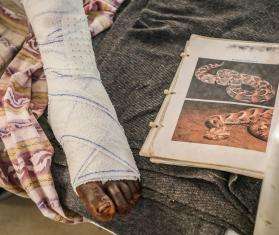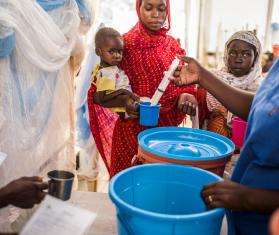Tom Brown—a locally produced flour mix of grains, soy, and peanuts inspired by a traditional Nigerian recipe—is being used to combat malnutrition in northwest and northeast Nigeria, and may be able to reach more children for the same cost as ready-to-use therapeutic foods.
Since April 2024, health care facilities supported by Doctors Without Borders/Médecins Sans Frontières (MSF) in northwest and northeast Nigeria have recorded an unprecedented surge in children admitted for acute malnutrition. While struggling to provide lifesaving medical care to an ever-increasing number of young patients, MSF teams also try to reinforce community-led responses. One example is in Kebbi state, where MSF outreach teams are educating people about the Tom Brown recipe.
Like all other states in the northern part of Nigeria, Kebbi state experienced a colossal spike in malnutrition cases this year. In May, close to 1,000 children were admitted for severe malnutrition in the inpatient therapeutic feeding center set up by MSF at Maiyama Hospital—an 80 percent increase compared to the same period last year. The trend has continued since then, with more than 260 patients admitted in the second week of July. The 210-bed facility is so overwhelmed that patients regularly must share beds.
In addition to this intensive treatment facility, more than 11,000 children were enrolled in the outpatient nutrition treatment program supported by MSF at five smaller health centers in Kebbi state.
“The level of this crisis calls for big efforts in prevention activities,” said Maryam Muhammad, head of the MSF health promotion team in Kebbi. “That is why we also run outreach activities at the community level, to help parents avoid the worst for their children.”

A local solution for malnutrition
Four days a week, Maryam and her team hit the roads of Kebbi, traveling from community to community in a car packed with tables, saucepans, pots, spoons, and recycled soda bottles filled to the brim with soybeans, sorghum, moringa leaves, palm oil, and groundnuts.
“That’s all we need for Tom Brown demonstrations,” she said while on the way to Maishaika, a village located 25 miles from MSF’s inpatient feeding center. “This, and some catchy songs to make sure the recipe stays in everyone’s head.”
Inspired by a traditional Nigerian recipe known as kwash pap, the Tom Brown flour blend is consumed as a sweetened porridge. The meal is made with nutritious ingredients that are cultivated in northern Nigeria and available in local markets, and has been improved over the years by nutritionists to become a useful and efficient tool to prevent and treat moderate malnutrition. Studies conducted in Nigeria in 2022 and 2023 showed positive results on the use of the Tom Brown recipe for children with moderate acute malnutrition, and it is potentially able reach more children for the same cost as ready-to-use therapeutic food such as peanut paste.

Teaching families the Tom Brown recipe
After a 35-minute ride, the jeep pulls into Maishaika and Maryam and her colleagues greet a village elder. A few minutes later, the crew sets into motion. Tables, chairs, and ingredients are unpacked and set up while volunteers go from home to home to invite villagers to join. In a flash, the small village square transforms itself into a market stall and a hundred women covered with colorful scarves rapidly gather on chairs and on the ground to see what’s happening.
Maryam has worked as a health promoter for more than 15 years and knows how to catch and keep the crowd’s attention. Full of energy, with a booming voice and a spoon in her hand, she explains what acute malnutrition is and what they, mothers and grandmothers, can do to fight it.
Rapidly, she puts words into action and calls on a woman from the audience. She explains what will help keep acute malnutrition at bay: Tom Brown. In Kebbi, the recipe is based on a simple ratio: six parts sorghum or millet, three parts soybeans, and one part peanuts. After soaking, cleaning, drying, and roasting, the ingredients are finely ground into a powder, which is then mixed with clean water and cooked into a porridge.
“The men will have a dedicated session on another day,” said Maryam. “For cultural reasons, we must separate the sessions. But having them on board is key as they are the ones who supply the family [with food]. So we decided to have dedicated father-led sessions to show what we do and what we say. This helped a lot and now, men are showing real interest in such sessions.”
Prevention, not a cure
After an hour of demonstration for the women of the village, Maryam and her team pack up their equipment and call on all the mothers to stay and have their children screened for acute malnutrition through a rapid check using the mid-upper arm circumference measuring tape known as a MUAC bracelet. Among the 28 children screened that day, more than a third of them are referred to MSF’s therapeutic nutrition program.
“This kind of cooking demonstration is crucial because people understand that they can prevent their children from becoming acutely malnourished rather than bringing them to a facility to treat them [when they are already malnourished],” she said before jumping into the jeep. “Prevention will always be better than a cure. MSF will not remain here forever, so sustainable approaches are needed to reduce severe malnutrition. And we know that the people we train today will pass the recipe to others.”

Based on market availability, preferences, and what the family can afford, additional elements such as palm oil, moringa leaves, cow milk, or meat can be added to provide extra energy and nutrients to the dish. But with families facing rampant inflation—the highest in the three last decades —and a continuous increase in the price of food items over the past months, adding additional ingredients is luxury that many cannot afford in Kebbi.
The way to prepare the recipe is sung on repeat, and cups are handed over to children to taste-test as women laugh and smile. A few yards away, the village elder watches the event with curiosity.
Promoting adequate infant feeding is core to addressing malnutrition alongside reinforcing access to health care and food security. Between January and May 2024, Maryam and the health promotion team organized 554 demonstrations around Kebbi. More than 13,300 people attended these events, including 1,461 men.
As important as these efforts are, they remain a drop in the ocean compared to the needs in the northern belt of Nigeria. According to recent statistics, nearly 4.4 million children under five were suffering from acute malnutrition between May 2023 and April 2024 in northeast and northwest Nigeria. More must be done by the authorities and their partners to tackle malnutrition.




